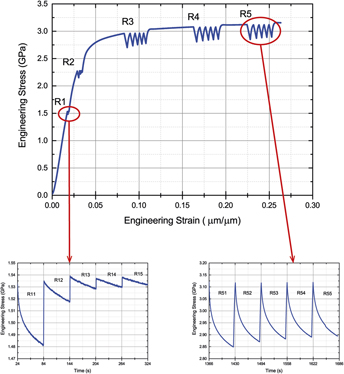Crossref Citations
This article has been cited by the following publications. This list is generated based on data provided by
Crossref.
Guo, Y.
Schwiedrzik, J.
Michler, J.
and
Maeder, X.
2016.
On the nucleation and growth of {112¯2} twin in commercial purity titanium: In situ investigation of the local stress field and dislocation density distribution.
Acta Materialia,
Vol. 120,
Issue. ,
p.
292.
Godard, Pierre
Renault, Pierre-Olivier
Faurie, Damien
and
Thiaudière, Dominique
2017.
Relaxation mechanisms in a gold thin film on a compliant substrate as revealed by X-ray diffraction.
Applied Physics Letters,
Vol. 110,
Issue. 21,
Kang, Wonmo
Merrill, Marriner
and
Wheeler, Jeffrey M.
2017.
In situ thermomechanical testing methods for micro/nano-scale materials.
Nanoscale,
Vol. 9,
Issue. 8,
p.
2666.
Wehrs, Juri
Deckarm, Michael J.
Wheeler, Jeffrey M.
Maeder, Xavier
Birringer, Rainer
Mischler, Stefano
and
Michler, Johann
2017.
Elevated temperature, micro-compression transient plasticity tests on nanocrystalline Palladium-Gold: Probing activation parameters at the lower limit of crystallinity.
Acta Materialia,
Vol. 129,
Issue. ,
p.
124.
Ramachandramoorthy, Rajaprakash
Wang, Yanming
Aghaei, Amin
Richter, Gunther
Cai, Wei
and
Espinosa, Horacio D.
2017.
Reliability of Single Crystal Silver Nanowire-Based Systems: Stress Assisted Instabilities.
ACS Nano,
Vol. 11,
Issue. 5,
p.
4768.
Maier-Kiener, Verena
and
Durst, Karsten
2017.
Advanced Nanoindentation Testing for Studying Strain-Rate Sensitivity and Activation Volume.
JOM,
Vol. 69,
Issue. 11,
p.
2246.
Ast, Johannes
Mohanty, Gaurav
Guo, Yi
Michler, Johann
and
Maeder, Xavier
2017.
In situ micromechanical testing of tungsten micro-cantilevers using HR-EBSD for the assessment of deformation evolution.
Materials & Design,
Vol. 117,
Issue. ,
p.
265.
Gupta, Saurabh
and
Pierron, Olivier N.
2017.
A MEMS Tensile Testing Technique for Measuring True Activation Volume and Effective Stress in Nanocrystalline Ultrathin Microbeams.
Journal of Microelectromechanical Systems,
Vol. 26,
Issue. 5,
p.
1082.
Guillonneau, Gaylord
Mieszala, Maxime
Wehrs, Juri
Schwiedrzik, Jakob
Grop, Serge
Frey, Damian
Philippe, Laetitia
Breguet, Jean-Marc
Michler, Johann
and
Wheeler, Jeffrey M.
2018.
Nanomechanical testing at high strain rates: New instrumentation for nanoindentation and microcompression.
Materials & Design,
Vol. 148,
Issue. ,
p.
39.
Edwards, Thomas Edward James
Di Gioacchino, Fabio
Mohanty, Gaurav
Wehrs, Juri
Michler, Johann
and
Clegg, William John
2018.
Longitudinal twinning in a TiAl alloy at high temperature by in situ microcompression.
Acta Materialia,
Vol. 148,
Issue. ,
p.
202.
Chen, Wufan
Kitamura, Takayuki
and
Feng, Miaolin
2018.
Effect of geometrically necessary dislocations on inelastic strain rate for torsion stress relaxation of polycrystalline copper in micro scale.
Materials Science and Engineering: A,
Vol. 726,
Issue. ,
p.
137.
Godard, P.
Faurie, D.
Sadat, T.
Drouet, M.
Thiaudière, D.
and
Renault, P.O.
2019.
X-ray diffraction and stress relaxations to study thermal and stress-assisted annealings in nanocrystalline gold thin films.
Acta Materialia,
Vol. 173,
Issue. ,
p.
87.
Conte, Marcello
Mohanty, Gaurav
Schwiedrzik, Jakob J.
Wheeler, Jeffrey M.
Bellaton, Bertrand
Michler, Johann
and
Randall, Nicholas X.
2019.
Novel high temperature vacuum nanoindentation system with active surface referencing and non-contact heating for measurements up to 800 °C.
Review of Scientific Instruments,
Vol. 90,
Issue. 4,
Guo, Song
He, Yuming
Li, Zhenkun
Lei, Jian
and
Liu, Dabiao
2019.
Size and stress dependences in the tensile stress relaxation of thin copper wires at room temperature.
International Journal of Plasticity,
Vol. 112,
Issue. ,
p.
278.
Kong, Charlie
Cheong, Soshan
and
Tilley, Richard D.
2019.
Comprehensive Nanoscience and Nanotechnology.
p.
327.
Foiles, Stephen M
Abdeljawad, Fadi
Moore, Alexander
and
Boyce, Brad L
2019.
Fatigue-driven acceleration of abnormal grain growth in nanocrystalline wires.
Modelling and Simulation in Materials Science and Engineering,
Vol. 27,
Issue. 2,
p.
025008.
Yan, Y.
Chen, W.
Sumigawa, T.
Wang, X.
Kitamura, T.
and
Xuan, F. Z.
2020.
A Quantitative In Situ SEM Bending Method for Stress Relaxation of Microscale Materials at Room Temperature.
Experimental Mechanics,
Vol. 60,
Issue. 7,
p.
937.
Gupta, Saurabh
Stangebye, Sandra
Jungjohann, Katherine
Boyce, Brad
Zhu, Ting
Kacher, Josh
and
Pierron, Olivier N.
2020.
In situ TEM measurement of activation volume in ultrafine grained gold.
Nanoscale,
Vol. 12,
Issue. 13,
p.
7146.
Chen, Ming
Wehrs, Juri
Sologubenko, Alla S.
Rabier, Jacques
Michler, Johann
and
Wheeler, Jeffrey M.
2020.
Size-dependent plasticity and activation parameters of lithographically-produced silicon micropillars.
Materials & Design,
Vol. 189,
Issue. ,
p.
108506.
Gubicza, Jenő
Kapoor, Garima
Ugi, Dávid
Péter, László
Lábár, János L.
and
Radnóczi, György
2020.
Micropillar Compression Study on the Deformation Behavior of Electrodeposited Ni–Mo Films.
Coatings,
Vol. 10,
Issue. 3,
p.
205.





